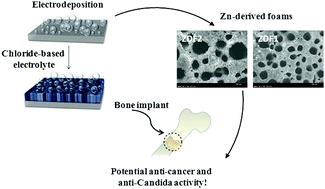Potential anti-cancer and anti-Candida activity of Zn-derived foams
Abstract
Zinc (Zn)-derived foams have been prepared from an alkaline electrolyte solution by galvanostatic electrodeposition under different conditions. A detailed physico-chemical characterization was performed by Raman spectroscopy, X-ray diffraction (XRD) and scanning electron microscopy (SEM). A pioneer application of these foams in medical implant-related applications was investigated. The in vitro behaviour of these Zn-derived foams in simulated physiological conditions was studied. The results revealed that the presence of zinc oxide was important enough to change the in vitro behaviour of these materials. The potential of these Zn-derived foams in inhibiting bone cancer cell proliferation – osteoscarcoma cells – and important pathogenic fungi responsible for implant-related infections – Candida albicans – was examined. Furthermore, the foams were evaluated for cytocompatibility with normal human osteoblasts. The results obtained allowed us to conclude that Zn-derived foams have an interesting potential for anti-cancer and anti-Candida activity, targeted for bone-related implant applications, suggesting that this novel material may have potential for further clinical studies.



 Please wait while we load your content...
Please wait while we load your content...